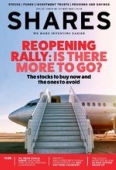Archived article
Please note that tax, investment, pension and ISA rules can change and the information and any views contained in this article may now be inaccurate.
Expert Investor: Why you should look at free cash flow when assessing stocks

It’s often said that profits are an opinion, only cash is fact. Plenty of businesses that have appeared healthy on standard accounting measures have ended up failing due to a lack of cash flow, as documented by Terry Smith three decades ago in his book Accounting For Growth and more recently by Tim Steer in The Signs Were There.
Many investors, especially those like Smith who favour high-quality companies, look for businesses which can produce sustainably high cash flows year after year, which can be reinvested in the business to create future value for shareholders.
Cash flow is the operating cash a company generates in a given period. It is calculated as the operating profit after non-cash items such as depreciation and the investment made in working capital such as inventory, creditors and debtors.
Put simply, it measures how much money is coming into the business, where it’s coming from, and how much is going out again. When a company ends the year with more cash from operations than it had at the start of the year, it has generated positive free cash flow.
A simple way to calculate a free cash flow yield is to divide the cash generated from operations by the company’s market capitalisation. If a firm makes £100 million of cash flow and has a market value of £1 billion, its free cash flow yield is 10%.
In reality, few firms can consistently generate a 10% free cash flow yield based on their market cap let alone based on enterprise value.
For Terry Smith, who calls free cash flow yield his ‘primary valuation yardstick’, a yield close to 6% is normal and still represents a significant cushion over government bonds, which is important because the coupon on government bonds doesn’t grow over time whereas the free cash flow from his companies does.

‘If we can buy them with a higher free cash flow yield than the bond yield, then we have probably created value,’ says Smith.
The downside of using free cash flow yield is that the calculation uses a company’s market value which doesn’t account for debt. Therefore, a better way is to divide the cash flow figure by the enterprise value, which is the market value of a business plus long-term debt plus minority interests and preferred capital (typically preference shares) minus cash.
This gives a more accurate picture of the actual capital employed in generating the cash flows. It also helps when comparing stocks in different sectors with different capital structures.
Enterprise value to free cash flow is the inverse of the free cash flow yield. The lower the ratio, the faster a company can pay back the cost of an acquisition or generate cash to reinvest in its business.
The accompanying table shows the FTSE 100 stocks with the lowest enterprise value to free cash flow ratio – remember, the lower the number the better.
When we screened for the data, the list was dominated at the lower end by financial companies, such as banks and insurers. These have been stripped out because enterprise value is not appropriate for this sector. Financials need to hold a lot of capital and it is hard to get an accurate picture of net debt with these firms.
Important information:
These articles are provided by Shares magazine which is published by AJ Bell Media, a part of AJ Bell. Shares is not written by AJ Bell.
Shares is provided for your general information and use and is not a personal recommendation to invest. It is not intended to be relied upon by you in making or not making any investment decisions. The investments referred to in these articles will not be suitable for all investors. If in doubt please seek appropriate independent financial advice.
Investors acting on the information in these articles do so at their own risk and AJ Bell Media and its staff do not accept liability for losses suffered by investors as a result of their investment decisions.
Issue contents
Editor's View
Feature
Great Ideas
- It could be takeover time again for Premier Foods
- Why it is not too late to profit from the SDI growth story
- Gamma Communications to hit top of range forecasts in 2021
- Walmart delivers with upgrade to forecasts as it gains market share
- Ford accelerates electrification drive with new battery plant and latest F-150 truck
- Supreme is a super-charged growth and income play

 magazine
magazine








